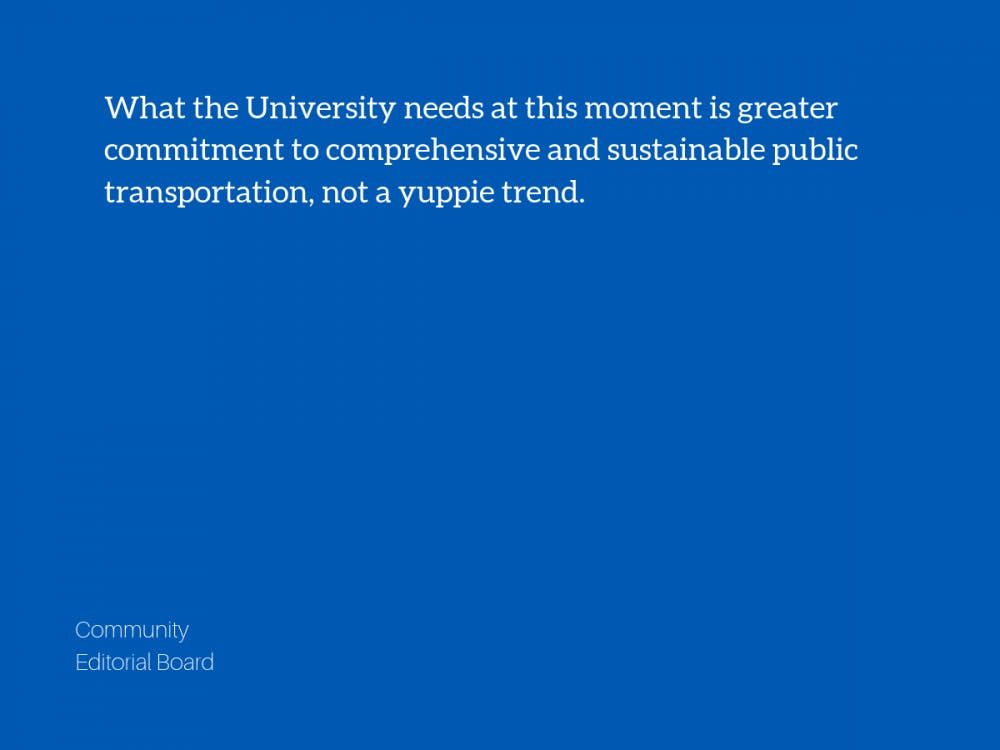The Community Editorial Board is fully independent of the editorial staff of The Chronicle.
In its 95th academic year, the gothic campus has been revived with the common sights of students braving the lines during the claustrophobic West Union lunch hours and falling back into their caffeine-sustained work routines. New among these usual sightings are the electric scooters dotted across campus following approval from Duke and the City of Durham over the summer.
Scooters admittedly hold some merit—especially when the trip is short. The baseline price and cost per distance traveled on a scooter are much cheaper than popular ride-share services. Scooters, when parked properly, decrease the volume of traffic. Getting to those hard-to-reach places has become easier for people on campus whose needs are excluded from limited bus routes. Beyond Duke, scooters could potentially improve mobility in low-income areas.
However, the arrival of scooters deserves critical scrutiny, as they are the University’s latest contribution to the ongoing conversation about access. Realistically, few students will go more than a couple of miles off-campus on the glorified toys, limiting their practical value. Per University guidelines, scooters will not operate in high volume areas, and riders must adhere to a series of safety protocols. Yet you’d be hard pressed to see anyone wearing a helmet or even obeying traffic laws, and injuries have already proved themselves common. There are also physical accessibility concerns as their use is limited for able-bodied people traveling a short distance with a very light load. From an economic standpoint, although the cost may seem relatively insignificant for some, it can be a significant accumulative cost for others, resulting in a stratification of use.
The use of scooters, especially in tandem with nearly 700 students moving from Central to West, seems symptomatic of how West Campus may have been pushed beyond its carrying capacity. This has brought to the forefront the chronic transportation issues at Duke. It’s the second week of classes, and students have already raised concerns about how buses are more packed, sidewalks are more cramped and Blue Zone spaces are frustratingly scarce. Duke has an obligation to provide students with reliable transportation between campuses and has the funds. This historic centralization of non-first-year students provided the perfect opportunity for Duke to recommit to a sustainable, accessible vision for public transportation. Instead, the only immediate action from upper administration was the mere addition of an extra East-West route.
Beyond students, getting around Duke and Durham has become a nuisance at best and impossible at worst for many students, staff, faculty, and residents. Faculty face similar hurdles with transportation on and off campus. The latest University estimates reveal that 16 percent of Duke’s total emissions are the result of employees commuting to and from campus. Hidden in that alarming statistic is the fact that 80 percent of employees drive to work individually and that, compared to figures from 2007, the average employee lives an added 3 miles away from campus. Once on campus, Duke employees struggle to find parking close to their workplace—if they can find it at all.
As noted, this is not Duke’s first public transportation-related faux pas. Questions about the future of the Robertson Express exposed Duke’s convoluted relationship with on-campus public transit systems. Last year’s decision to not be involved in GoTriangle’s light rail left many students, at best, confused and, at worst, enraged. The lack of funding from Duke nearly killed the Bull City Connector—the fare-free bus that connects students, employees, and University and Hospital visitors between Duke Hospital and Downtown Durham. Instead, the University now funds a private shuttle from campus to its downtown properties—an exclusive service only available to those with a valid DukeCard. Duke’s recent history indicates a move away from publicly accessible bus routes and toward intimate, private transportation methods.
What the University needs at this moment is greater commitment to comprehensive and sustainable public transportation, not a yuppie trend. So far, there are plans to add two electric buses to its fleet by 2020 and reach carbon-neutrality by 2024. But there is much more ground to cover, and the only intuitive solution for navigating our community comes via an expansion of Duke’s public transportation services. On campus, this means an overhaul of the bus system to adapt to changing campus demands. It means expanding parking options in sustainable ways (no more flat lots, please). It means an urgent pivot to environmentally sustainable ways to navigate campus without an added cost to users. In the community, it looks like refunding projects like the Bull City Connector or collaboratively reimagining what city-wide transportation could look like. When the opportunity arises, the University must rise to the occasion and demonstrate a greater commitment to sustainability, inclusivity and accessibility, which can’t be achieved with electric scooters.
Get The Chronicle straight to your inbox
Sign up for our weekly newsletter. Cancel at any time.

